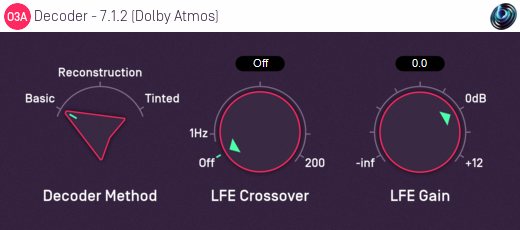O3A Decoder - 7.1.2 (Dolby Atmos)

Host Support
| Host Type | Support |
|---|---|
| AAX | Yes |
| VST2 | Yes |
Audio
| Channels | Content | |
|---|---|---|
| Input | 16 | O3A |
| Output | 10 | 7.1.2 (Dolby Atmos) |
Controls
Description
This plugin takes a third order ambisonics (O3A) mix and decodes it as 7.1.2.
7.1.2 is a standard mix format for beds in Dolby Atmos. It adds two ceiling channels to standard 7.1.
Channels
The channel ordering used is:
| Channel | AAX | VST |
|---|---|---|
| 1 | Front Left | Front Left |
| 2 | Front Centre | Front Right |
| 3 | Front Right | Front Centre |
| 4 | Left Surround Side | LFE |
| 5 | Right Surround Side | Left Surround Rear |
| 6 | Left Surround Rear | Right Surround Rear |
| 7 | Right Surround Rear | Left Surround Side |
| 8 | LFE | Right Surround Side |
| 9 | Left Top Surround | Left Top Surround |
| 10 | Right Top Surround | Right Top Surround |
Please note that the channel ordering used by Dolby's Atmos RMU may differ. Also, the AAX order above is used when plugins interact with ProTools through the AAX software interface; other parts of ProTools may use a different default order, for instance when exporting to file.
The plugin is available in the O3A Decoding plugin library.
Controls
Control: Method
Three methods are supported, "Basic", "Reconstruction" and "Tinted Reconstruction". Generally, "Basic" is recommended except where the speaker rig to be used for playback is known and has been set up accurately.
| Method | Description |
|---|---|
| Basic | This method produces a resilient decoding which should play well on a range of speaker systems including large venues. |
| Reconstruction | This method controls the soundfield at the centre of the listening space to produce a clearer spatial image. It relies on the speaker layout being set up accurately. |
| Tinted Reconstruction | This variant of the Reconstruction method performs HRTF-based tinting on the audio stream to strengthen the spatial image. Again, it relies on the speaker layout being set up accurately. |
Control: LFE Crossover
This determines if any audio is sent to the LFE channel. It may be set to "Off" and this is recommended. If enabled, audio is extracted from the main mix into the LFE channel using the indicated crossover frequency (between 1 and 200Hz).
Control: LFE Gain
If the LFE gain is active, this gain is applied to it. Some export formats may need this set to -10dB to take into account a +10dB gain applied during playback.
- O3A Brickwall
- O3A Decoder - 22.2
- O3A Decoder - 3D7.1
- O3A Decoder - 5.1
- O3A Decoder - 7.1
- O3A Decoder - 7.1.2 (Dolby Atmos)
- O3A Decoder - 7.1.4
- O3A Decoder - Auro-3D 10.1
- O3A Decoder - Auro-3D 11.1
- O3A Decoder - Auro-3D 13.1
- O3A Decoder - Auro-3D 9.1
- O3A Decoder - Cube
- O3A Decoder - Headphones
- O3A Decoder - Hexagon
- O3A Decoder - IMAX 12.0
- O3A Decoder - IMAX 5.0
- O3A Decoder - IMAX 6.0
- O3A Decoder - N3D
- O3A Decoder - Octagon
- O3A Decoder - Quad
- O3A Decoder - Quad Binaural
- O3A Decoder - UHJ Stereo
- O3A Meter - Karma
- Stereo Crosstalk Cancellation
